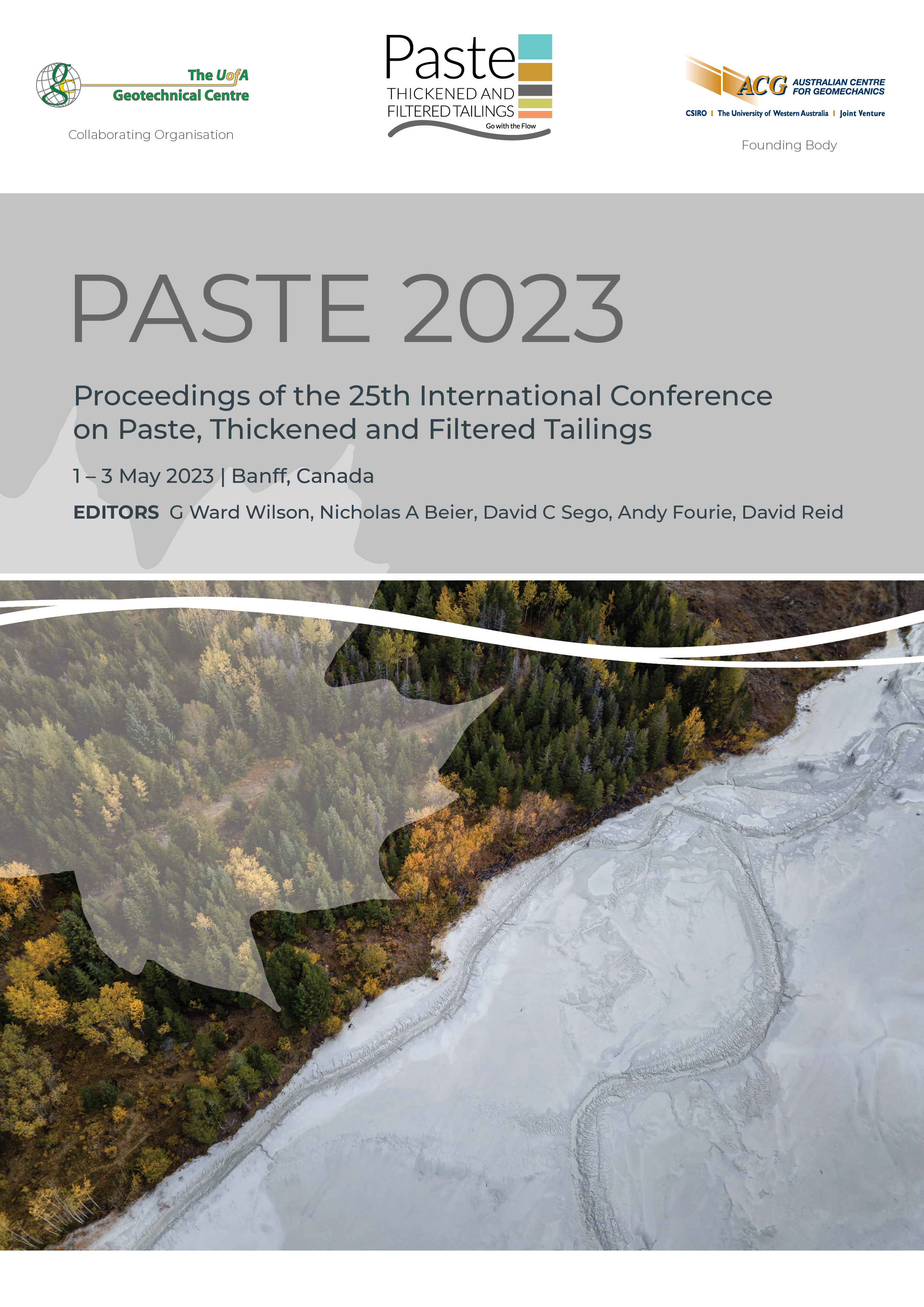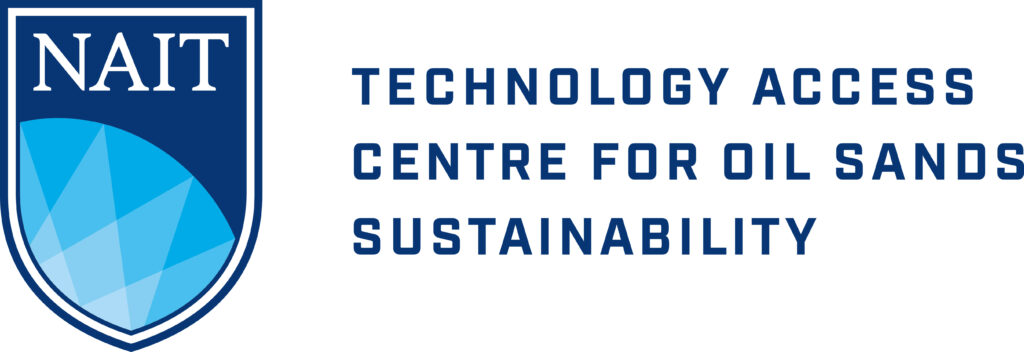Assessment on consolidation behaviours of treated fluid fine tailings using applied suction method

|
Authors: Fisseha, BT; Wilson, GW; Fredlund, DG |
DOI https://doi.org/10.36487/ACG_repo/2355_38
Cite As:
Fisseha, BT, Wilson, GW & Fredlund, DG 2023, 'Assessment on consolidation behaviours of treated fluid fine tailings using applied suction method', in GW Wilson, NA Beier, DC Sego, AB Fourie & D Reid (eds), Paste 2023: Proceedings of the 25th International Conference on Paste, Thickened and Filtered Tailings, University of Alberta, Edmonton, and Australian Centre for Geomechanics, Perth, pp. 510-525, https://doi.org/10.36487/ACG_repo/2355_38
Abstract:
Large volumes of fluid tailings have been produced by the oil sands mining operations in Northern Alberta using bitumen extraction processes. The produced tailings pose a challenge to the operators due to low compressibility behaviour of materials in the tailing pond as a result of the low hydraulic conductivity and high thixotropic strength. Deposited tailings that are ready to be reclaimed require being consolidated and have adequate strength. Consolidated and developed strength of the deposited tailings need to provide adequate bearing capacity, which is pivotal in establishing the basis for reclamation work such as the capacity to carry the machinery that carry out the reclamation work. Field trials display formation of both unsaturated and saturated zones within the deposited tailings following the deposition of fully saturated tailings. The development of the unsaturated zone requires the removal of moisture from freshly deposited slurry materials. The unsaturated zone development can be attained during design stage by using various dewatering technologies. The presence of the unsaturated zone significantly enhances consolidation properties of the deposited tailings due to dewatering of tailings using the applied suction method. This paper will present results of laboratory experiments carried out to assess consolidation behaviours of freshly deposited treated fluid fine tailings using the applied suction method. The laboratory experiment was conducted using a meso-scale column made of Plexiglas and a PVC base with a high air-entry value ceramic disc with dimensions of 300 mm diameter and 500 mm height. Consolidation of fluid fine tailings obtained using column tests were assessed using standard large-strain compressibility curves and predicted using unsaturated engineering properties. Results were checked and consistent with fundamental principles of unsaturated soil mechanics. Experimental test results from the meso-scale test were compared with standard engineering property testing methods and discussed.
Keywords: consolidation of tailings, applied suction, unsaturated properties of tailings
References:
Beier, N, Alostaz, M & Sego, D 2009, ‘Natural dewatering strategies for oil sands fine tailings’, Proceedings of Tailings and Mine Waste 2009 Conference, The University of Alberta Geotechnical Centre and Oil Sands Tailings Research Facility, Edmonton,
pp. 845–858.
Fair, AE & Beier, NA 2012, ‘Collaboration in Canada’s oil sands: fluid fine tailings management’, Proceedings of the 3rd International Oil Sands Tailings Conference, University of Alberta Geotechnical Center and Oil Sands Tailing Research Facility, Edmonton, pp. 3–12.
Fisseha, B, Bryan, R & Simms, P 2010, ‘Evaporation, unsaturated flow, and salt accumulation in multilayer deposits of a gold “paste” tailings’, ASCE Journal of Geotechnical and Geoenvironmental Engineering, vol. 136, no. 12, pp. 1703–1712.
Fisseha, B 2020, Experimental Study on Consolidation Behaviour and Shear Strength Gain for Saturated/Unsaturated Treated Fluid Fine Tailings, PhD thesis, University of Alberta, Edmonton.
Fisseha, B, Wilson, GW & Fredlund, DG 2017a, ‘Assessment of Large-Strain Consolidation and Shear Strength of Saturated/Unsaturated Fluid Fine Tailings’, Proceedings of the 70th Canadian Geotechnical Conference and the 12th Joint CGS/IAH-CNC Groundwater Conference, The Canadian Geotechnical Society, Ottawa.
Fisseha, B, Wilson, GW & Fredlund, DG 2017b, ‘Large-strain consolidation column with applied negative water pressure’, Proceedings of Second Pan American Conference on Unsaturated Soils, Unsaturated Soils Technical Committee of the Geo-Institute of the American Society of Civil Engineers, Dallas.
Fisseha, B, Wilson, GW & Simms, P 2018, ‘Assessment of self-weight consolidation of flocculated fluid fine tailings under various environmental conditions’, in RJ Jewell & AB Fourie (eds), Paste 2018: Proceedings of the 21st International Seminar on Paste and Thickened Tailings, Australian Centre for Geomechanics, Perth, pp. 291–304,
ACG_rep/1805_23_Fisseha
Fisseha, B, Wilson, GW & Fredlund, DG 2022, ‘Shear strength assessment of consolidated treated fluid fine tailings using applied suction method’, Proceedings of Tailings and Mine Waste Conference, Colorado State University, Denver.
Fredlund, DG, Rahardjo, H & Fredlund, MD 2012, Unsaturated Soil Mechanics in Engineering Practice, John Wiley and Sons, Hoboken.
Imai, G 1981, ‘Experimental studies on sedimentation mechanism and sediment formation of clay materials’, Soils and Foundations, vol. 21, no. 1, pp. 7–20,
Jeeravipoolvarn, S, Masala, S, Zhang, C & Moore, T 2015, ‘Revisiting the large strain consolidation test for oil sands’, Proceedings of the Tailings and Mine Waste Conference, Colorado State University, Denver,
Innocent-Bernard, T 2013, Evaporation, Cracking, and Salinity in a Thickened Oil Sands Tailings, MSc thesis, Carleton University, Ottawa.
Mizani, S, He, X & Simms, P 2013, ‘Application of lubrication theory to modelling stack geometry of high density mine tailings’, Journal of Non-Newtonian Fluid Mechanics, vol. 198, pp. 59–70.
Mizani, S, Simms, P, Dunmola, A, Côté, C & Freeman, G 2014, ‘Rheology for surface deposition of polymer-amended fine tailings’, in RJ Jewell, AB Fourie, PS Wells & D van Zyl (eds), Proceedings of the 17th International Seminar on Paste and Thickened Tailings, InfoMine, Vancouver, pp. 295–306.
Morgenstern, NR & Scott, JD 1995, ‘Geotechnics of fine tailings management’, in YB Acar & DE Daniel (eds), Geoenvironment 2000: Characterization, Containment, Remediation, and Performance in Environmental Geotechnics, ASCE, New York,
pp. 1663–1683.
Simms, P, Grabinsky MW & Zhan, G 2007, ‘Modelling evaporation of paste tailings at the Bulyanhulu mine’, Canadian Geotechnical Journal, vol. 44, no. 12, pp. 1417–1432.
Simms, P, Dunmola, A, Fisseha, B, and Bryan, R 2010, ‘Generic modelling of desiccation for cyclic deposition of thickened tailings to maximize density and to minimize oxidation’, In Proceedings of the 13th International Conference on Paste and Thickened Tailings, Toronto, Ontario, May 3rd to 6th 2010, pp. 293-301.
Soleimani, S., Simms, P., Dunmola, A., Freeman, G., & Wilson, G. W. 2014. ‘Desiccation and consolidation in thin-lift deposition of polymer amended mature fine tailings’,In Proceedings of the 17th International Seminar on Paste and Thickened Tailings, Vancouver, B.C. InfoMine.
Sulfate, EB, Wilson, W, Wijiewickreme, D, Simms, P 2010, ‘Predicting void ratio in surface deposited paste tailings’, In Proceedings of Mine Waste 2010, Perth, Australia, 29th September- 1st October, p. 473-48.
Yao, Y 2016, ‘Dewatering Behaviour of Fine Oil Sands Tailings’, An Experimental Study. PhD thesis, Delft University of Technology.
© Copyright 2024, Australian Centre for Geomechanics (ACG), The University of Western Australia. All rights reserved.
View copyright/legal information
Please direct any queries or error reports to repository-acg@uwa.edu.au
View copyright/legal information
Please direct any queries or error reports to repository-acg@uwa.edu.au



